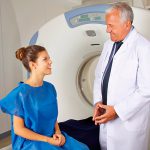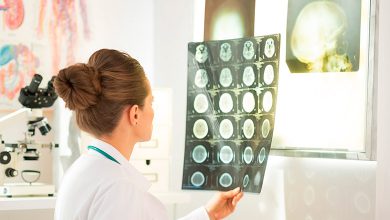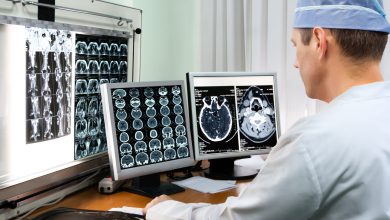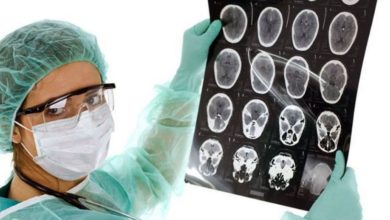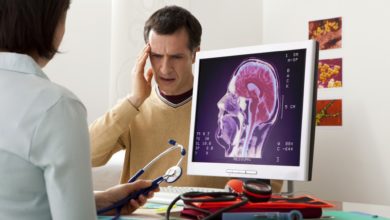All about brain cancer in children: causes, symptoms, treatment
The content of the article
- Development and classification of the disease
- Brain cancer in children: stages of development
- Localization and frequency of tumors
- The importance of early diagnosis
- Diagnostic methods
- Dangerous brain tumor in a child: first signs
- Signs of a brain tumor in children, features of manifestation
- Symptoms of brain cancer in children depending on location
- Clinical symptoms of brain cancer in young children
- Brain tumor - symptoms in the early stages in adolescents
- Brain tumor in children - treatment methods
a headache in the morning , this is an alarm bell that makes parents wary. It is possible that trouble has come to your family and its name is a brain tumor. Symptoms in the early stages in children vary depending on where it is located.
As the disease develops, areas that have an impact on the child’s life are affected. The future health and life of the child will depend on the timeliness of contacting a qualified specialist. Knowing the first symptoms of brain cancer in children, you can diagnose the disease in time and begin treatment at an early stage of development.
Development and classification of the disease
Brain cancer in children is an uncommon oncological disease, accompanied by the appearance of malignant formations both inside the skull and on its surface. The formation of tumors that form inside the skull or spinal canal is caused by uncontrolled cell division.
Based on the main characteristics, a brain tumor is divided into:
- Primary. It develops initially from the tissues of the membranes of the brain.
- Secondary. The primary cause of tumor development is neoplasms in other organs, which over time metastasize to the brain.
It is customary to distinguish 12 categories of brain tumors, the symptoms of which in children are divided depending on the composition of the cells. There are about 100 types of the disease. The most common are neuroepithelial, pituitary, meningeal, dysembryogenetic and foci not formed in brain tissue.
A neuroepithelial tumor develops from brain tissue cells. This type includes ependymoma , glioma , and astrocytoma . The neuroepithelial type accounts for about 60% of all malignant primary tumors.
Meningeal types are provoked by abnormal uncontrolled division of the membrane of the brain; pituitary types are formed during the division of pituitary cells. Incorrect cell division during embryogenesis leads to the formation of dysembryogenetic tumors.
Symptoms of brain cancer in children are differentiated from healthy cells. The high similarity of neoplasms to the structure of healthy tissue facilitates diagnosis. When several levels of differentiation are detected, the development of cancer is detected by infected cells. The offensive and rapid course of the disease is characteristic of cells that are not identical in structure.
Brain cancer in children: stages of development
The patient's life expectancy is influenced by the degree of development of the disease. A distinctive property of brain cancer is the transformation of tissues in the central nervous system. To determine what stage of development the disease is at, it is necessary to carry out a number of additional diagnostic methods. Based on the results of diagnostic studies, further treatment is determined.
There are 4 stages of brain cancer development, each with specific symptoms:
- First or initial stage. When brain cancer is detected by symptoms in the early stages in children, doctors give a favorable prognosis. With timely treatment, complete recovery is possible. The first signs of a brain tumor do not particularly manifest themselves due to their slow growth, so it is almost impossible to detect them.
- Second stage. At this stage of development, the tumor grows, affecting some brain structures. At the second stage, signs of a brain tumor in children appear more pronounced. Nausea, headaches appear, and blood pressure rises. In addition, it is difficult for the child to concentrate, his mood changes sharply, and memory lapses occur. If the tumor is not detected at this stage of development, the child’s life is in serious danger.
- Third stage. At this stage, the tumor actively grows, penetrating deeper into the tissues and brain. Serious disturbances occur in the functioning of the nervous system. Signs of a brain tumor in children at the third stage of development are manifested by rapid weight loss, high fatigue, vomiting, and lack of coordination. In addition, hearing, vision, memory and speech deteriorate, numbness of the limbs and anemia are observed.
- Fourth stage. At this stage of development, cancer cannot be treated: the tumor becomes inoperable . Irreversible changes occur in the body, and they affect not only the central nervous system, but also organs that are part of the area controlled by the part of the brain affected by tumors.
Brain cancer in children, in addition to the symptoms listed above, may be accompanied by complete or partial paralysis and impaired sense of smell. If the frontal lobe of the brain is affected, a personality defect is observed.
Localization and frequency of tumors
Malignant neoplasms in children can be localized in the hemispheres, midline and posterior cranial fossa.
In the hemisphere, tumors of neuroectodermal origin (gliomas) develop, which are part of a heterogeneous group. They are diagnosed in 37% of patients.
In the midline of the brain, chiasmal gliomas are diagnosed in 4% of cases - tumor formations formed from glial cells located in the area of the optic nerve, in 8% - craniopharyngiomas, in 2% - pineal gland tumors.
In the posterior cranial fossa, brainstem gliomas and cerebellar astrocytomas are diagnosed with equal frequency (15%), medulloblastomas are diagnosed in 14%, and ependyomas are diagnosed in 4%.
The importance of early diagnosis
According to experts, early diagnosis of cancer is the first step on the path to recovery. The chances of survival directly depend on the stage of the disease: the earlier the tumor is diagnosed, the better the effect of treatment. Unfortunately, as practice shows, children with cancer are admitted to specialized medical institutions when the cancer is already at stages 2-4. With the first stage, no more than 10% of patients are admitted to hospitals, and it is at this stage that treatment methods are more gentle on the child’s body, and are also effective.
It is also important that the cost of treatment for stage 1 cancer is the lowest. At the second stage, the price of treatment increases by 3.6 times, the third – by 5 times, and in the fourth – by 5.5.
Diagnostic methods
If you find signs of a brain tumor in children, you should immediately visit a specialist to confirm or refute the diagnosis. Cancer is detected using the following methods:
- CT scan . The procedure is carried out using a computer and an X-ray machine. Computed tomography allows you to get clear images of the desired area of the body, and they can be taken from different angles. In some cases, when it is necessary to improve the visibility of internal organs and tissues, a dye (intravenous contrast material) may be injected into the patient's blood.
- MRI (magnetic resonance imaging). Images used to diagnose or refute oncology. It is obtained using radio waves, a magnetic field and a computer. Before the procedure begins, the patient may be given gadolinium. This is a contrast agent, which, after passing through the vessels, accumulates in the affected area, thanks to which the specialist can accurately determine the size and structure of the tumor.
- Biopsy. This diagnostic study involves opening the skull to collect biomaterial from a suspicious area using a needle. A pathology specialist carefully examines the biomaterial under a microscope, and if cancer cells are detected, the tumor is removed by surgery.
Dangerous brain tumor in a child: first signs
The clinical picture of childhood pathology has its own characteristics. This is due to the fact that children have an immature central nervous system. In addition, the children's central nervous system is characterized by high adaptability and plasticity; therefore, the oncological disease proceeds without symptoms for a long period, and the first signs of a brain tumor in children appear when the tumor is relatively large.
A brain tumor in a child has the following symptoms:
- Irritability, loss of interest in what was interesting before (games, hobbies);
- Frequent whims of the child, crying for no apparent reason (especially for newborns and young children), complaints of pain in the head;
- Typical symptoms of poisoning. Vomiting and nausea usually appear in the first half of the day, regardless of food intake;
- Deterioration of hearing and vision;
- Change in gait;
- Memory problems, speech impairment;
- The appearance of convulsions, seizures, short-term loss of consciousness;
- Systematic nosebleeds;
- Disturbances in the functioning of the endocrine system;
- Poor breathing, difficulty swallowing, problems with bowel movements (it is difficult for the child to go to the toilet).
The appearance of all these symptoms is due to compression of brain structures and nerves undamaged by the tumor, a delay in the outflow of cerebrospinal fluid, an increase in intracranial pressure, or the penetration and accumulation of biological fluids, cellular elements and various chemicals into good tissues.
Signs of a brain tumor in children, features of manifestation
- Prolonged, intense headaches of a paroxysmal nature, accompanied by nausea, vomiting, and hearing and vision deterioration. The pain is not relieved by painkillers. In young children, this symptom is manifested by restlessness, screaming, refusal to eat, combined with sleep disturbances;
- The occurrence of causeless vomiting, usually observed in the morning. Due to the growth of the tumor, gastric emptying will become more frequent;
- Lethargy, drowsiness of the child, loss of interest in previous activities, fatigue, or, on the contrary, irritability, hyperactivity. There are changes in character and behavior;
- Impaired motor function, manifested by limping, ataxia;
- Forgetfulness, absent-mindedness, deterioration in school performance, memory loss;
- Change in speech. The child begins to speak slowly, with words clearly divided into syllables. This symptom also includes failure to pronounce individual sounds and disturbances in the construction of sentences;
- Episyndrome, manifested by epileptic seizures, while a focus of epiactivity does not form. These include absence seizures, loss of consciousness, tonic-clonic seizures of varying intensity and duration;
- A brain tumor in a child has other symptoms. These may include impaired vision, hearing, difficulty swallowing and breathing, nosebleeds, and poor urinary and fecal continence.
Symptoms of brain cancer in children depending on location
With abnormal formations developing in different areas of the brain and spinal cord, the symptoms differ from each other. Problems with specific functions indicate where exactly the tumor has formed.
Symptoms of a brain tumor in children, depending on the specific location, include:
- New growths in the large and outer parts of the brain. In such cases, control over motor function is lost, the child feels weakened, and sometimes the disease is accompanied by numbness on one side of the body.
- Neoplasms inside the skull are accompanied by headaches, problems with well-being and poor coordination of movements. Children under four years of age may experience increased head size (macrocephaly) and nausea. Often the course of the disease is accompanied by an irritable state and lethargy. A brain tumor in a child in the first years of life manifests itself with symptoms in the early stages in the form of refusal to eat, poor digestion, weakness and increased tearfulness. Factors accompanying the disease include hyperflexion and damage to the cranial nerves.
- Tumors that form in the central part of the brain are characterized by symptoms such as unusual eye movements, squinting, and other general symptoms.
- Neoplasms developing in the forebrain lead to loss of speech and lack of language skills. The child may not even understand the words.
- A tumor in the back of a child's brain, or formed around the pituitary gland, causes damage to the optic nerves.
- Localized in the basal ganglia, it is responsible for body movements and position.
- In the cerebellum area they cause problems with coordination of movements, walking and eating.
- Neoplasms that form near cranial nerves are accompanied by hearing loss, problems with balance, swallowing and facial muscles.
- Abnormal gait, cranial nerve palsy, headache, and strabismus indicate the presence of tumors in the brain stem.
- When spinal cord cancer develops in children, they experience weakness, numbness, poor coordination, and bowel and bladder problems.
Clinical symptoms of brain cancer in young children
It is important for parents to know that a brain tumor in a child shows its first signs at an early age differently, in contrast to the clinical manifestations of the disease in adolescents.
Intracerebral neoplasms at an early age are manifested by the development of internal hydrocephalus. This is explained by the fact that a tumor located in the middle of stem , optic chiasm or cerebellum begins to grow into the lateral ventricles. In such cases, the outflow of cerebrospinal fluid is disrupted, and the following symptoms appear:
- The head increases in circumference, significantly exceeding age norms, the bones of the skull are deformed, the head enlarges on the side of the tumor (asymmetry).
- The fontanel bulges, the stitches come apart.
- The child is lagging behind in terms of physical and psycho-emotional development.
- The network of blood vessels on the head becomes enlarged, and the veins bulge.
- The baby becomes whiny, often crying monotonously. This is most likely due to headaches that the child cannot talk about.
- The baby burps frequently and profusely, and vomiting appears, regardless of food intake.
- There are changes in the movements of the eyeballs (become uncontrollable), strabismus. Twitching of the eyes and the appearance of uneven movements in the form of a “setting sun” are possible.
- The appearance of convulsions, chaotic movements of the arms. The child may freeze for no reason.
Brain tumor - symptoms in the early stages in adolescents
Brain tumors can be of different types, and the consequences of cancer are very sad.
The onset of the disease in adolescents is characterized by the following symptoms:
- Systematic and long-lasting headaches;
- Complete indifference to what is happening around, lethargy, drowsiness;
- Change in behavior, irritability, anger;
- Memory deterioration, poor academic performance (concerns its decline);
- Symptoms of poisoning not related to food ingested;
- Refusal to eat;
- Dizziness;
- Changes in gait, speech and even handwriting;
- Deterioration of hearing and vision;
- The appearance of convulsions, loss of consciousness;
- With cerebral edema, a teenager has difficulty understanding what is happening around him; it is difficult for him to concentrate and make decisions on his own.
The disease is often accompanied by elevated body temperature. If parents are alarmed by the sick appearance of their child, they should urgently consult a doctor. When negative symptoms appear, it is important to know what exactly is causing the health problem. And the sooner this is done, the higher the chances of recovery. This applies not only to cancer.
Causes brain cancer in children:
- Heredity;
- Radiation exposure;
- Long-term exposure to toxins;
- Exposure to ultraviolet rays.
A brain tumor, like any other cancer, negatively affects the condition of the body as a whole. The category of the disease is determined using a test.
Brain tumor in children - treatment methods
If possible, the tumor is removed by surgery. To do this, the skull is opened and the tumor is completely or partially removed. After removing the infected area, the skull is restored using titanium plates. Craniotomy is performed only at the first stage of cancer development.
Cancer is partially removed in cases where it is localized in the brain itself and any interventions can only aggravate the situation. Partial removal helps reduce intracranial pressure and liquor hypertension. Chemotherapy is used to destroy any remaining cancer cells. In any case, during surgery, doctors remove as large a piece of damaged tissue as possible.
After cancer is removed, no specialist can guarantee that cancer cells will not spread to neighboring areas. The possibility of relapses occurring years later cannot be ruled out. Children with cancer need to be constantly examined to monitor the situation. After the operation, additional diagnostic measures (MRI or computer topography) are mandatory to evaluate the results.
Please rate the article:

